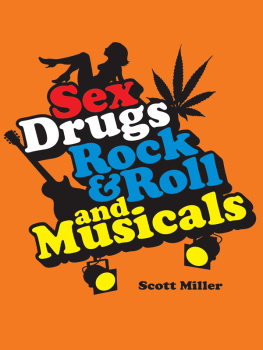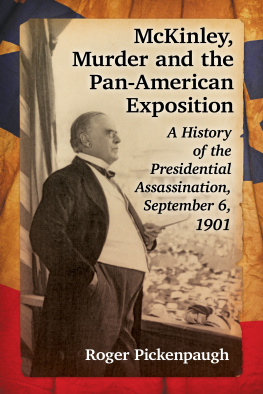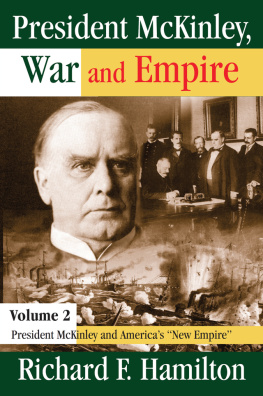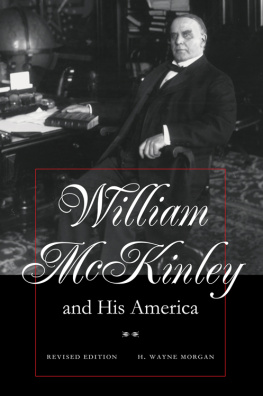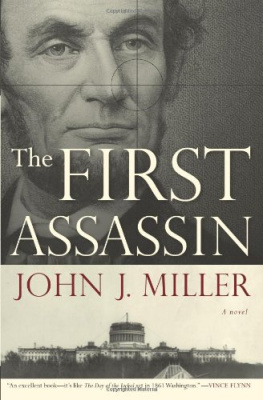Scott Miller - The President and the Assassin: McKinley, Terror, and Empire at the Dawn of the American Century
Here you can read online Scott Miller - The President and the Assassin: McKinley, Terror, and Empire at the Dawn of the American Century full text of the book (entire story) in english for free. Download pdf and epub, get meaning, cover and reviews about this ebook. year: 2011, publisher: Random House, genre: Non-fiction. Description of the work, (preface) as well as reviews are available. Best literature library LitArk.com created for fans of good reading and offers a wide selection of genres:
Romance novel
Science fiction
Adventure
Detective
Science
History
Home and family
Prose
Art
Politics
Computer
Non-fiction
Religion
Business
Children
Humor
Choose a favorite category and find really read worthwhile books. Enjoy immersion in the world of imagination, feel the emotions of the characters or learn something new for yourself, make an fascinating discovery.
- Book:The President and the Assassin: McKinley, Terror, and Empire at the Dawn of the American Century
- Author:
- Publisher:Random House
- Genre:
- Year:2011
- Rating:4 / 5
- Favourites:Add to favourites
- Your mark:
- 80
- 1
- 2
- 3
- 4
- 5
The President and the Assassin: McKinley, Terror, and Empire at the Dawn of the American Century: summary, description and annotation
We offer to read an annotation, description, summary or preface (depends on what the author of the book "The President and the Assassin: McKinley, Terror, and Empire at the Dawn of the American Century" wrote himself). If you haven't found the necessary information about the book — write in the comments, we will try to find it.
The President and the Assassin: McKinley, Terror, and Empire at the Dawn of the American Century — read online for free the complete book (whole text) full work
Below is the text of the book, divided by pages. System saving the place of the last page read, allows you to conveniently read the book "The President and the Assassin: McKinley, Terror, and Empire at the Dawn of the American Century" online for free, without having to search again every time where you left off. Put a bookmark, and you can go to the page where you finished reading at any time.
Font size:
Interval:
Bookmark:


Copyright 2011 by Scott Miller
All rights reserved.
Published in the United States by Random House,
an imprint of The Random House Publishing Group,
a division of Random House, Inc., New York.
R ANDOM H OUSE and colophon are registered
trademarks of Random House, Inc.
LIBRARY OF CONGRESS CATALOGING-IN-PUBLICATION DATA
Miller, Scott.
The president and the assassin: McKinley, terror, and empire
at the dawn of the American century / by Scott Miller.
p. cm.
eISBN: 978-0-679-60498-3
1. McKinley, William, 18431901. 2. McKinley, William, 18431901Assassination. 3. Czolgosz, Leon F., 1873?1901. 4. United StatesPolitics and government18971901. 5. United StatesSocial conditions18651918. 6. United StatesTerritorial expansionHistory19th century. 7. AnarchismUnited StatesHistory. I. Title.
E711.M45 2011 973.88dc22 2010038857
www.atrandom.com
Jacket design: Joe Montgomery
Jacket images: President William McKinley (Library of Congress), Leon Czolgosz (The Granger Collection), Buffalo Pan-American Exposition (University of Buffalo)
v3.1
To Mom

TEMPLE OF MUSIC
They streamed among the manicured flower beds and dewy lawns of Delaware Park that early September morning in Buffalo, New York, a portrait of America in the Gilded Age. Women in full-length skirts and tight-fitting corsets in the fashion of the iconic Gibson Girl shaded themselves with parasols. The men, seeking relief from the sun with jauntily perched straw boaters, fingered coins deep in their pockets, confident in their jobs. Children in sailor suits skipped and laughed and pulled their parents along as fast as they could. The smoky aroma of grilling bratwurst, the echo of chirping piccolos and booming tubas, the bellow of an elephant, all signaled they had nearly reached the grounds of the Pan-American Exposition of 1901.
As the crowds drew nearer, a series of pillars, each topped with a horse and rider, could be discerned through the trees. Beyond them stood massive domed buildings in red and yellow, preceded by the stout Triumphal Bridge. The view was capped by the signature structure of the Expo, the 389-foot-high Electric Tower, lit with power generated
This was an especially exciting day. The Buffalo papers were reporting that William McKinley, beloved president of the United States, would meet members of the public at the Temple of Music at 4 P.M . The previous day, a record 116,000 people had crowded through the gates to see him deliver what many considered one of his finest speeches, and the prospect of actually exchanging a handshake or a brief word was an experience not to be missed. Such one-on-one encounters were a favorite of the president. Meeting with people individually, he projected a natural sincerity and warmth. So much time did McKinley spend in receiving lines that he perfected his own handshake, the McKinley grip, to prevent cramping. When confronted with a long reception line, he made a point of extending his hand first and clasping the others fingers so he couldnt be squeezed back. Then he would grab hold of his visitors elbow with his left hand and deftly move him along,
But plans for this particular meet-and-greet had left McKinleys staff feeling uneasy. The event had been well publicized and raised serious security issues. George B. Cortelyou, the presidents personal secretary, had twice removed the Temple of Music reception from McKinleys schedule, and the president had twice demanded that it be reinstated. Though McKinley was the most popular president since Abraham Lincoln four decades earlier, pockets of dangerous radicals lurked in many cities. Only weeks before, his Secret Service agent George Foster, who looked the part of a professional sleuth with his derby hat and a cigar clenched between his teeth, had chased off a shadowy stranger from the McKinleys private home in Canton, Ohio.
Cortelyous nerves had been put even more on edge when, on the evening of September 4, 1901, the special three-car train the president and his wife were riding in pulled into the Terrace Station overlooking Lake Erie in Buffalo. Cannons set up by the Coast Guard to salute McKinley had been placed too near the tracks and, when fired, produced a thunderous report that shattered eight windows on the train and sent shards of glass flying inside. In a brief panic on the station platform, a dozen or so people, their minds quickly racing to the most likely assailant, shouted Anarchists!
The reaction was understandable. The notorious exploits of anarchists had become, in the minds of many citizens, a very real and horrifying threat to the American way of life. Anarchist newspapers printed directions for making explosives at home and preached the downfall of the U.S. government. Radical believers of the political philosophy that rejected authority in any form had committed a sickening stream of terrorist attacks on European kings and heads of state. In the United States, anarchists had been convicted of bombing the police and nearly succeeded in murdering the manager of the nations largest steel company. The president, however, had never been one to worry about his own security and brushed aside pleas that he limit his exposure to the public. No one would wish to hurt me, he chuckled.
On the evening of August 31, 1901, a slightly built young man entered the barroom of John Nowaks saloon at 1078 Broadway on Buffalos east side and asked for a room. Clad in a gray suit with a black shoestring tie, he carried a telescope-shaped bag in one hand and a brown hat with a yellow ribbon in the other. He struck Nowak as a fair sort of man and possessed a dreamy look.questionable breeding, thought it somewhat odd but didnt care what he called himself as long as he paid in advance. Nowak asked Frank Walkowiak, a clerk at the hotel who was studying law, to show the man to a room on the second floor. Walkowiak was more curious than his boss. What made you say John Doe? he asked as they trudged upstairs.
Well, Ill tell you, Im a Polish Jew and I didnt like to tell him or he wouldnt keep me in the house. Pressing the point, Walkowiak asked the guest his real name. Nieman, Fred Nieman. Im going to sell souvenirs.
Nobody could figure out what the man who called himself Nieman was really doing in Buffalo. He generally rose early and left the hotel for the day. In the evening he would return with a collection of newspapers tucked under his armthe Express, the Courier, the Times, the Commercialand head straight to his room. He occasionally bought a cigar or a good whiskey, not the cheap five-cent shots, and stopped once or twice to watch a card game in the barroom, but he hardly ever spoke. The only time anyone paid him any attention was one morning when he noisily searched for a water pitcher, disturbing a retired German army officer trying to sleep in a nearby room.
Stuffed deep in his coat pocket, however, was one artifact that indicated a keen interest in world affairsa neatly folded and well-worn newspaper clipping about the assassination of Italian king Umberto I. An Italian American named Gaetano Bresci, an editor of an anarchist newspaper in New Jersey, had murdered the monarch a year earlier. Nieman read it carefully. Sometime during the first week of September he stopped by Walbridge Hardware at 316 Main Street and asked to see a silver-plated Iver Johnson .32-caliber revolverthe same model that Bresci had used against Umberto I. At $4.50, the weapon was priced well above the other handguns that ran closer to $1.50, but he couldnt resist acquiring the premium model. Back in his hotel room, he loaded the weapon with five Smith & Wesson cartridges and practiced wrapping the gun and his right hand in a white handkerchief.
Font size:
Interval:
Bookmark:
Similar books «The President and the Assassin: McKinley, Terror, and Empire at the Dawn of the American Century»
Look at similar books to The President and the Assassin: McKinley, Terror, and Empire at the Dawn of the American Century. We have selected literature similar in name and meaning in the hope of providing readers with more options to find new, interesting, not yet read works.
Discussion, reviews of the book The President and the Assassin: McKinley, Terror, and Empire at the Dawn of the American Century and just readers' own opinions. Leave your comments, write what you think about the work, its meaning or the main characters. Specify what exactly you liked and what you didn't like, and why you think so.


